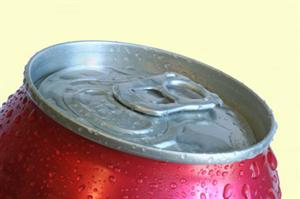| Complexity level: | 7 |
| Project cost ($): | 20 |
| Time required: | 1 hour to prepare, 1 hour for experiment |
| Material availability: | Easily found. May be purchased at a supermarket. |
| Safety concerns: | None |
Hypothesis
Regular Coke and Diet Coke will both sink in water
Overview
Density
The density of a substance or matter, is the mass of one unit volume of that matter. For example the density of water is 1gram/cm3.
Density = mass (gram) / volume (cm3)
When an object has a density that is higher than the medium it is placed into, then that object will sink in that medium. Similarly if the density of the medium is higher than the density of the object, the object will float in that medium.
For example, hydrogen has a density of 0.0001g/cm3 compared to air which has a density of 0.0013g/cm3. This is the reason why hydrogen inflated balloons will float in the air.
Similarly, water has a density of 1g/cm3. Copper has a density of 8.9g/cm3 and will immediately sink in water. Wood on the other hand has a density of 0.53g/cm3 only and it will float in water.
The method to determine the density of an object is to first check the weight of the object with a weighing machine. The next step is to determine its volume. If the shape of the object makes it difficult to measure its volume, find a measuring cup or beaker that is big enough to contain the object. Place the object in the cup and fill it with water. Record the volume of the water in the cup. Remove the object from the water. The difference between the level of the water with the object and without the object is the volume of the object.
Scientific Terms
Materials
The materials required for this science fair project:
- 1 empty aquarium tank
- 1 pail of tap water (we will use about 5 liters)
- 1 can of regular coke
- 1 can of diet coke
- 1 kg of sugar
Procedure
1. For this experiment, the independent variable is the density of the regular coke and diet coke. The dependent variable is whether the can will float or sink in water. This is determined by observing the cans after they are placed in the water. The constants (control variables) are the density of the water, the temperature of the water and volume of the tank.
2. The water tank is filled with 5 liters of water. The depth of the water in the tank must be at least 150mm.
3. The cans of regular coke and diet coke are placed in the water.
4. Observation is made to ascertain whether the cans float or sink in the water - these observations are recorded in the table below.
5. The 1 kg of sugar is dissolved in the water inside the fish tank.
6. Observe whether the cans float or sink in the water and record the finding in the table below.
Results
The results show that Diet Coke will float in tap water whereas Regular Coke will sink in it. However when 1 kilogram of sugar is added to the water, both the Regular Coke and Diet Coke cans start to float in the water.
Tank content |
Regular Coke |
Diet Coke |
Tap water |
Sinks |
Floats |
Tap water and 1 kg of sugar |
Floats |
Floats |
Conclusion
The hypothesis that Regular Coke and Diet Coke will sink in water is not proven.
Item |
Regular Coke |
Diet Coke |
Water |
335g |
335g |
Sugar |
39g |
- |
Nutra sweet |
- |
0.1g |
Total weight |
374g |
335.1g |
Volume of can |
335ml |
335ml |
Density = Weight / volume |
1.11 g/ml |
1.00 g/ml |
The density of water is 1.0 g/ml. The regular coke can has a density higher than that of water and therefore it sinks in the water. The Diet Coke has a density that is the same as water and therefore floats in the water.
When 1kg of sugar is added to 5 liter of water, the water's density becomes,
1.0 g/ml + 1000g/5000ml = 1.2 g/ml
After the sugar is added to the water, the density of both the cans becomes less than the sugared water. Therefore both the cans will float in the tank.
Also consider
1. Repeat the above experiment using turpentine or alcohol instead of water. However, be extremely careful when handling flamable liquids such as alcohol/turpentine (Adult supervision required, and the experiment should be done in a well equiped laboratory with proper safety gear/equipment).
2. Try to compare the results by using different types of soda cans.
References
Density - http://en.wikipedia.org/wiki/Density
Which is more dense – Coke or Diet Coke - http://www.elmhurst.edu/~chm/vchembook/121Adensitycoke.html

